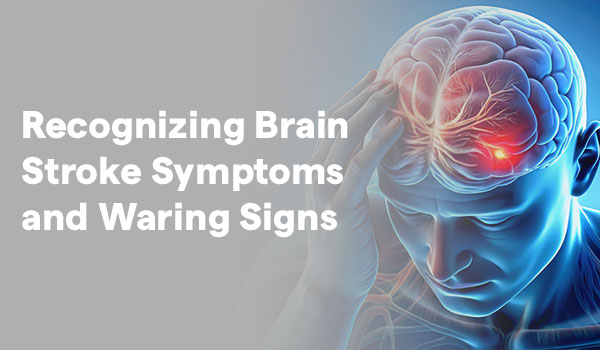
A stroke happens when blood supply to a part of the brain is cut off so neurons in the affected area die due to a lack of oxygen. Stroke can occur when an artery in the brain is constricted (ischemic stroke) or when a blood vessel bursts and spills blood inside the skull (hemorrhagic stroke).
Strokes have severe outcomes if not detected early and no amount of intervention is as important as immediately contacting a specialist when anyone experiences its symptoms. The most common early warning signs and symptoms of stroke include:
● Numbness and/or weakness of the face, arm, or leg, and these abnormalities must be sudden and only on one side of the body. This is the most prevalent sign of a stroke and anyone who experiences such a signal knows there is something wrong with a brain. Tug your ear lobe or try to whistle – if your face droops on one side or you can only raise one arm, it might be a warning sign of a stroke.
● Dizzy spells due to the head-spinning; loss of speech, which may come and go; and the inability to understand words that are spoken. Sudden confusion, slurred speech, or difficulty understanding others may be a sign of a stroke in the language areas of the brain.
● A sharp loss of vision in one or both eyes. A stroke may also include the sudden onset of double vision, blurred vision, or loss of vision in one-half of the visual field.
● New numbness or tingling, severe weakness, or loss of strength in your legs, arms, or upper body. The disease can destabilize certain regions of the brain that are in charge of balance and coordination. The person may go through it frequently and experience a seizure affecting the person’s ability to walk.
● Severe headache of abrupt onset with no identifiable cause. A sudden onset of severe headache is suggestive of hemorrhagic stroke. This headache also referred to as the worst headache ever experienced is the prominent sign of brain stroke.
In addition to these main symptoms, other possible signs of a stroke include:
Strokes occur and they have risk factors like age, high blood pressure, diabetes, smoking, obesity, high cholesterol, and a history of stroke in the family. Those with atrial fibrillation, an irregular heart condition, are also at a significantly increased risk as well. It has also been stated that women are more vulnerable during pregnancy, during childbirth, and even in the period after childbirth to brain stroke.
If any signs of a stroke appear, the first and the most important action that should be taken is to call an ambulance or medical help from a specialist from the best neurology hospital in Delhi. A series of diagnostic and treatment indices should be performed quickly to avoid the loss of brain tissue and optimize the results. It may also involve CT scans or MRIs to try and identify the nature and exact location of the stroke. Another is a measurement of blood sugar and cholesterol levels, EKG, oxygen saturation as well as reviewing heart rates. Therapies can be medicines that break up blood clots, invasive procedures that call for mechanical clot removal, or blood thinning drugs if the stroke is due to hemorrhaging.
That means one might wait for help and the worst may be that he or she causes a severe, permanent disability or dies. More to the point, for every minute that a stroke remains untreated, the brain loses close to 2 million cells. To avoid brain damage it is advisable to call for help immediately if you have evidence of a stroke. Some of the other ways to respond that are critical are identifying the exact timing of the onset of symptoms, writing down all the symptoms the patient has experienced to date on the first meeting with the doctors, and getting the list of current medications and medical history documented as well.
Strokes indicate quite differing long-term effects based on factors such as type and severity of a stroke, region affected in the brain, the time taken in providing treatment, age, and previous health conditions. Some ischemic injuries may be compensated with some residual neurological abnormality that can be alleviated by congregational physical therapy within weeks and months.
Worse strokes are either partial-body point paralysis or loss of speech/vision which can only partially develop further. Correct post-stroke mobilization is very effective in regaining some of the lost abilities. However, the acute awareness of the stroke symptoms is critical once they strike, and the need for help is to be sought. It can be the difference between no harm at all and devastating paralysis or fatality after a stroke.
Hence, the best chance of survival and subsequent survival is to act quickly when a stroke occurs. We all have to know such a sudden signal as face or arm drop, slurred speech, loss of vision or balance, and severe, very bad headaches. The first thing that patients should do after identifying a stroke is to call emergency help immediately, and to be able to receive an important and timely treatment that will reduce the amount of brain damage as well as increase the chance of regaining functionality among stroke survivors. Precious time is lost when cells are dying in the brain during an ischemic or hemorrhagic stroke, contacting specialists at the first glimpse of the sudden onset of the symptoms will go a long way in determining the future well-being of the stroke patient. For instant treatment facilities, book an appointment with Sir Ganga Ram Hospital today.